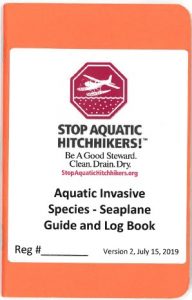Seaplane Pilots

Seaplanes and float planes have long been used on Lake Whatcom and Lake Samish, by visitors and residents alike. Seaplane pilots are helping to protect these local lakes from the threat of aquatic invasive species by following these required procedures, developed in cooperation with the Washington Seaplane Pilots Association, before using their seaplane on Lake Whatcom or Lake Samish:
- Enter into a Cooperative Agreement with the City of Bellingham stating that you will follow these procedures.
- View this seaplane pilot training video and take the test: Seaplane Pilot Training Aquatic Invasive Species. You’ll be able to print out your certificate after completing the test.
- Carry a copy of the Cooperative Agreement and your certificate on board and make it available for presentation in the case of a spot check by inspection staff.
- Pilots/owners with seaplanes based at Lake Whatcom or Lake Samish shall make an appointment with Lake Whatcom AIS inspection staff to get their plane inspected and permitted by calling (360) 778-7975 or sending an email to g.pw.ais@cob.org. The pilot/owner may also view and complete the Whatcom AIS Awareness Course to learn more. AIS permits are required for seaplanes and must be purchased online here as a “$60 annual registered permit.” The physical permit will be provided at the time of inspection. The permit may be affixed to the plane or kept with the inspection form in the cockpit.
To assist us in evaluating the effectiveness of this agreement we are requesting that seaplane pilots voluntarily submit the following information for each landing on Lake Whatcom or Lake Samish in a given year: 1) date of landing, 2) origin of the flight, and 3) other lakes visited on the trip. This information can easily be documented in the Aquatic Invasive Species – Seaplane Guide and Log Book (available by emailing ais@washingtonseaplanepilots.org).

Periodically submit this information (at least annually) to the AIS Program Staff at g.pw.ais@cob.org or 2221 Pacific Street, Bellingham, WA 98229.
Additional requirements when operating from infested waters:
Follow these procedures when traveling from waters known to be infested with aquatic invasive species:
- Prior to entering the seaplane, remove all aquatic plants (or attached mussels, snails, or other animals) from the exterior surfaces of floats, wires, cables and rudders and remove all water from floats, wheel wells and any other compartments or areas of the aircraft that could contain or maintain raw water.
- Prior to takeoff, raise and lower the rudders several times to remove aquatic plants, avoid taxiing through heavy surface growths of aquatic plants and make sure all floats remain as dry internally as possible during takeoff.
- After takeoff, raise and lower rudders several times to free any remaining aquatic plants while over the departing water body or over dry land. If aquatic plants persist and are still visible on floats, cables or rudders, return to the same water body and physically remove them.
- During storage and/or moorage, remove the aircraft from the water whenever practical to better facilitate self-inspection, drainage, plant removal, cleaning and drying.
- If you are visiting waters infested with invasive mussels, you should do the following before leaving the infested waterbody:
- Decontaminate any surfaces that have come in contact with the water using 140 degree, high pressure water.
- Where 140 degree water is not available, you should apply a 20 percent bleach solution, or other effective substitute, to the float bilges.





